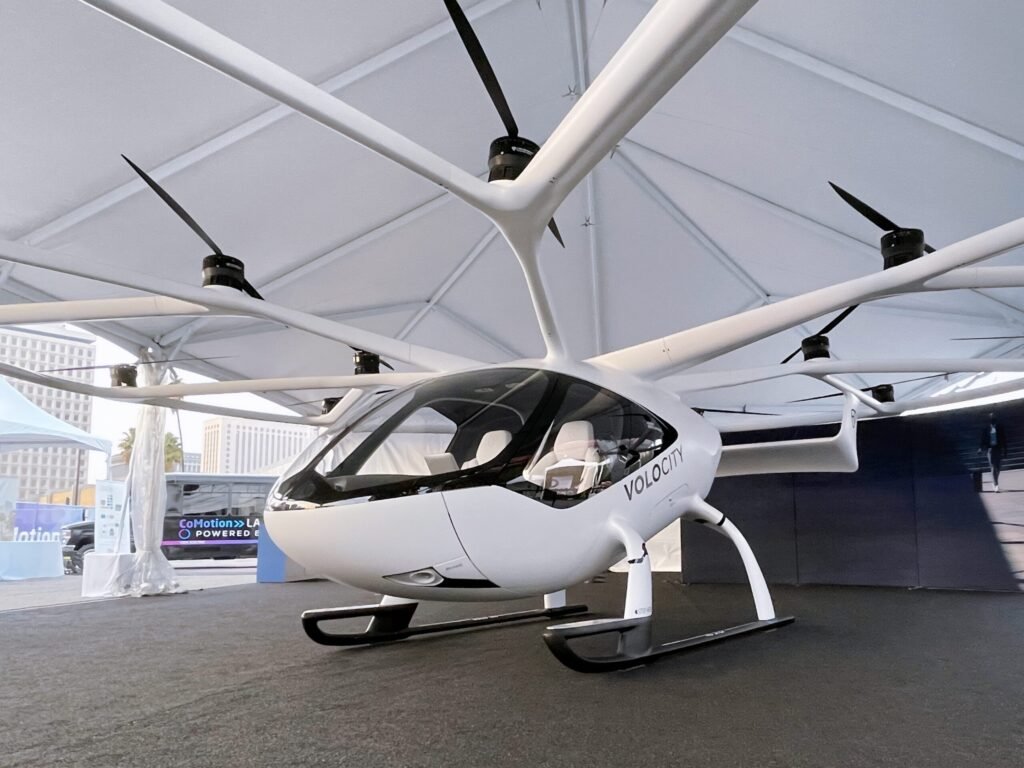At the National Business Aviation Association (NBAA)’s annual Business Aviation Conference and Expo (BACE), advanced air mobility (AAM) took center stage. A panel discussion at the event highlighted the immense potential of AAM for the business aviation industry. Participants shared exciting updates, such as Volocopter’s progress in obtaining type certification for its 2-seater piloted aircraft and Joby’s plans to initiate commercial flights by 2026, with global operations by 2028. Additionally, Wisk showcased their advanced autonomous air taxi, the 6th generation Cora aircraft, which is undergoing certification. The Federal Aviation Administration (FAA) showed enthusiasm for integrating electric vertical takeoff and landing (eVTOL) vehicles into existing airspace systems. Nonetheless, several challenges remain, including operational hurdles, infrastructure needs, noise concerns, and community engagement. OEMs are expected to handle both the manufacturing and operation of AAM vehicles, while advancements like CPDLC and AI/ML are set to impact the AAM system. Moreover, addressing people and cultural shifts, such as pilot shortages and cultivating interest in flying among young people, will be pivotal for the successful implementation of AAM.

This image is property of dronelife.com.
Overview of NBAA BACE and AAM
The National Business Aviation Association (NBAA) once again showcased the exciting world of advanced air mobility (AAM) at its annual Business Aviation Conference and Expo (BACE). This year, the focus was on the promises and potential benefits of AAM for the business aviation industry. With the growing interest in electric vertical takeoff and landing (eVTOL) aircraft, the conference provided a platform for industry stakeholders to discuss advancements and explore opportunities in this emerging field.
Panel Discussion on AAM Promise
One of the highlights of the NBAA BACE was a panel discussion that delved into the promise of AAM for the business aviation industry. Participants shared their views on how AAM can revolutionize air transportation, providing faster and more efficient travel for both individuals and companies. They emphasized the potential for increased connectivity and accessibility, as well as reduced congestion and travel times.
Benefits for the Business Aviation Industry
The panel participants also highlighted the numerous benefits that AAM can bring to the business aviation industry. With the ability to access smaller and more remote airports, AAM vehicles can offer greater flexibility in travel options. This can be particularly advantageous for companies operating in areas with limited commercial air service. AAM can also enhance productivity by reducing travel time and allowing for more frequent trips to multiple destinations in a single day.
Additionally, AAM has the potential to reduce costs by optimizing fuel efficiency and eliminating the need for costly infrastructure investments associated with traditional airports. This can make business aviation more accessible and affordable to a wider range of users. Furthermore, the electrification of air transportation can contribute to the reduction of carbon emissions, aligning with the industry’s commitment to sustainability.
Volocopter’s Type Certification Process
Volocopter, a leading player in the AAM industry, is currently in the midst of the type certification process for its 2-seater piloted aircraft. Type certification is a crucial step in ensuring the safety and airworthiness of the aircraft before it can be commercially operated. Volocopter’s aircraft, designed for urban air mobility, combines electric propulsion and vertical takeoff and landing capabilities to provide a new mode of transportation for urban dwellers.
Certification Status
At the NBAA BACE, Volocopter provided an update on the certification status of its aircraft. The company is making significant progress in the certification process, with successful flight tests and ongoing collaborations with regulatory authorities. Volocopter is committed to meeting the stringent safety standards required for certification, ensuring that its aircraft adheres to the highest level of operational and design safety.
Details of 2-Seater Piloted Aircraft
Volocopter’s 2-seater piloted aircraft is designed with passenger comfort and safety in mind. It features multiple redundancy in critical systems, ensuring the ability to safely land even in the event of a technical failure. The aircraft’s electric propulsion system offers quiet and emission-free operations, making it suitable for urban environments. With its vertical takeoff and landing capabilities, the aircraft can access congested areas and bypass traditional airport infrastructure.

This image is property of dronelife.com.
Joby’s Commercial Operation Plans
Joby, another key player in the AAM industry, has ambitious plans to start flying commercially in 2026 and have operations globally by 2028. This marks an important milestone in the development of the AAM industry, as Joby aims to provide on-demand air transportation services using its eVTOL aircraft. Joby’s aircraft, designed for both urban and regional mobility, offers a combination of speed, range, and efficiency.
Commencement of Commercial Flying
Joby’s timeline for commencing commercial flying demonstrates the company’s confidence in the readiness of its aircraft and the regulatory framework supporting AAM operations. By 2026, Joby aims to offer its services to individuals and businesses, revolutionizing the concept of air travel. This development opens up a new dimension of transportation, significantly reducing travel times and increasing accessibility.
Global Operations by 2028
By 2028, Joby plans to have operations globally, expanding its services to regions beyond its initial launch markets. This global expansion reflects the growing demand and potential for AAM not only as a means of transportation but also as a transformative industry. Joby’s ambition to establish a global network of AAM operations is a testament to the scalability and adaptability of the technology.

This image is property of dronelife.com.
Wisk’s Autonomous Air Taxi Development
Wisk, a partnership between Boeing and Kitty Hawk, is actively developing a fully autonomous air taxi known as Cora. Wisk is currently undergoing type certification for its 6th generation Cora aircraft, which represents the next step in the evolution of autonomous air transportation. The Cora aircraft has been designed with safety, convenience, and accessibility in mind, offering a new mode of transportation that reimagines urban mobility.
Type Certification for Cora Aircraft
Wisk’s pursuit of type certification for its Cora aircraft underscores the company’s commitment to ensuring the highest level of safety and regulatory compliance. Autonomous air taxis represent a significant technological advancement, requiring careful evaluation and validation to ensure their operational reliability. Wisk’s collaboration with regulatory authorities demonstrates a collaborative approach towards certifying autonomous vehicles and integrating them into existing airspace.
Features of 6th Generation Cora
The 6th generation Cora aircraft from Wisk boasts several features that set it apart as a pioneering autonomous air taxi. It is equipped with a hybrid electric powertrain, enabling quiet and emission-free operations. The aircraft incorporates vertical takeoff and landing capabilities, eliminating the need for traditional runways. With a cruising speed of 150 km/h and a range of up to 160 km, Cora is designed to provide efficient and convenient transportation within urban areas.

This image is property of dronelife.com.
FAA’s Approach to eVTOL Integration
The Federal Aviation Administration (FAA) is taking a methodical approach to integrating eVTOLs into the airspace. Recognizing the need for a careful and structured process, the FAA is adopting a crawl-walk-run approach. This approach allows for the gradual integration of eVTOLs while ensuring the highest level of safety and operational effectiveness.
Airspace Integration Strategy
The FAA’s airspace integration strategy involves working closely with industry stakeholders to develop and implement standards and regulations. Through collaborations and partnerships, the FAA aims to address the unique challenges and requirements of AAM operations. This includes establishing guidelines for air traffic management, infrastructure development, and certification processes.
Integration with Existing Systems
The FAA recognizes the importance of integrating eVTOLs with existing systems to ensure seamless operations and coordination in the airspace. This integration involves leveraging existing technologies and infrastructure, such as air traffic control systems, navigation aids, and communication networks. By building upon the foundation of the current aviation infrastructure, the FAA aims to create a harmonized and interoperable airspace environment for both traditional aircraft and eVTOLs.

This image is property of dronelife.com.
Challenges for AAM Implementation
While AAM holds immense promise, it also faces several challenges that need to be addressed before widespread implementation can occur.
Operational Hurdles
One of the primary challenges for AAM implementation is overcoming operational hurdles. This includes developing robust operational procedures, training pilots and operators, and establishing secure communication systems. Additionally, ensuring the safe and efficient integration of AAM vehicles into existing airspace requires careful planning and coordination with air traffic control authorities.
Infrastructure Requirements
AAM implementation also requires significant investment in infrastructure. This includes the development of vertiports and landing pads that can accommodate the unique characteristics of eVTOL aircraft. Furthermore, charging infrastructure for electric-powered AAM vehicles needs to be established to support their widespread use. These infrastructure requirements pose a significant challenge and require collaboration among industry stakeholders, urban planners, and government authorities.
Noise Concerns
Noise concerns are another factor that must be addressed in AAM implementation. As AAM vehicles operate closer to the ground and in urban areas, the potential for noise disturbances increases. Mitigating noise emissions and ensuring that AAM operations do not disrupt the quality of life for residents is essential. This necessitates the development of quieter propulsion systems and adherence to noise regulations.
Community Engagement
Engaging communities and gaining public acceptance is crucial for successful AAM implementation. There may be concerns and reservations regarding the safety, noise, and privacy implications of AAM vehicles. Therefore, it is essential to educate and involve communities in the decision-making process, ensuring that AAM operations are aligned with local needs and priorities. Building public trust and support is vital for the sustainable growth of the AAM industry.
Role of OEMs in AAM
Original equipment manufacturers (OEMs) are expected to play a pivotal role in the AAM industry, both in terms of manufacturing and operation.
Manufacturing and Operation
OEMs are responsible for designing, manufacturing, and maintaining AAM vehicles. As pioneers in the industry, they are at the forefront of technological advancements and innovation. OEMs play a crucial role in shaping the future of AAM, ensuring the safety, reliability, and performance of the aircraft they produce. Additionally, some OEMs may also be involved in operating AAM services, bringing their expertise and experience to the commercial aspect of the industry.
Responsibilities of OEMs
OEMs have numerous responsibilities in the AAM ecosystem. Apart from designing and manufacturing safe and efficient aircraft, they must also comply with regulatory requirements and certification processes. OEMs are also expected to conduct thorough testing and validation programs to ensure the reliability and airworthiness of their vehicles. Furthermore, OEMs have a role in collaborating with authorities, industry partners, and stakeholders to address challenges and drive the successful implementation of AAM.
Next-Generation Technologies Impacting AAM
Next-generation technologies such as Controller-Pilot Data Link Communications (CPDLC) and Artificial Intelligence/Machine Learning (AI/ML) are expected to have a significant impact on the AAM system.
CPDLC (Controller-Pilot Data Link Communications)
CPDLC enables digital communication between air traffic controllers and pilots, reducing the reliance on voice communications. By utilizing data links, CPDLC provides a more efficient and secure means of communication, enhancing situational awareness and facilitating digital coordination. The integration of CPDLC in AAM operations can streamline air traffic management and improve operational efficiency, contributing to the overall safety and effectiveness of the system.
AI/ML (Artificial Intelligence/Machine Learning)
AI/ML technologies have the potential to revolutionize various aspects of AAM, from route planning and optimization to predictive maintenance and airspace management. By harnessing the power of AI/ML algorithms, AAM systems can make intelligent decisions, adapt to changing conditions, and optimize performance. These technologies can enhance the reliability, efficiency, and safety of AAM operations, enabling the industry to unlock its full potential.
Considerations for AAM Implementation
Several considerations must be taken into account for the successful implementation of AAM, including the impact of pilot shortages, attracting young pilots, and cultural shifts and people factors.
Impact of Pilot Shortages
The aviation industry as a whole has been grappling with pilot shortages, and AAM is no exception. The demand for skilled and qualified pilots is expected to increase as AAM operations expand. Addressing pilot shortages requires proactive measures such as investing in pilot training programs, incentivizing pilots to join the AAM industry, and promoting career opportunities in this exciting new sector. By ensuring a sufficient pool of pilots, the AAM industry can meet growing demand and sustain its growth.
Attracting Young Pilots
Attracting young pilots to the AAM industry is crucial for its long-term success. The industry offers unique career opportunities that combine the thrill of flying with cutting-edge technology and innovation. To attract young pilots, it is important to raise awareness about the future of AAM, promote the industry’s positive impacts, and provide clear pathways for training and career progression. By nurturing young talent and fostering a passion for aviation, the AAM industry can build a strong workforce for the future.
Cultural Shifts and People Factors
AAM represents a significant cultural shift in air transportation. The adoption and acceptance of new technologies require a shift in mindset and a willingness to embrace change. Addressing the concerns and expectations of various stakeholders, including the public, regulators, and industry professionals, is essential for the successful implementation of AAM. Inclusive and transparent communication, engagement, and collaboration are vital in ensuring that the benefits of AAM are realized and that any challenges or reservations are effectively addressed.
In conclusion, the NBAA BACE served as a platform to showcase the promise of AAM and its potential benefits for the business aviation industry. The advancements made by companies like Volocopter, Joby, and Wisk highlight the significant progress in the development of AAM vehicles and operations. However, challenges such as operational hurdles, infrastructure requirements, and community engagement must be addressed for successful implementation. The role of OEMs, next-generation technologies, and considerations such as pilot shortages and cultural shifts further shape the future of AAM. With continued collaboration and innovation, AAM has the potential to revolutionize air transportation, offering faster, more efficient, and sustainable travel options for a wide range of users.

